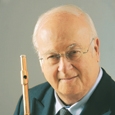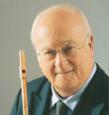When I was young I was in awe of interpretation; it seemed there must be unknown secrets that legendary teachers could unlock, somewhat like the builders of pyramids or the masons of Gothic churches. Time has taught me that the secrets lie within each of us.
I am still amazed at the capacity of my young students to bring out the inner meaning of music. I may criticize this or that technical aspect, inflection here, vibrato there, but in spite of the obvious temporary problems, they are able to make the work sing, bounce, speak, and bring in the listener. Unfortunately, I don’t think that this poetic dimension can be taught. It may be inspired and suggested, but it is within the student, like gold in the soil. The role of the teacher is not to turn dust into gold or a plough horse into a thoroughbred, but to prevent gold from remaining unformed or buried among anything that glitters. Therefore, a good mentor reveals the poetic dream that lies within us all, by increasing awareness of music’s construction, to be sure, through instrumental means, but also by cultivating imagination and perception of what lies between the notes and lines.
The teacher, however, must not dictate tempo, articulation, periodicity of vibrato, and dynamics, or hold any interpretation as final, labeled, and deep-frozen, as in the latest C.D. or edition. After all, these are only a photograph of someone’s ideas at a given point in time.
Young players are so prone to copy the latest recordings that repeated listenings build a sort of ghost interpretation. In the old days when I was a young professional, Jean-Pierre Rampal was my inspiration and one of the reasons I gave my life to the flute. His long-playing recordings were so dazzling that he was imitated by many here and in Europe. His inner life and charm stayed unique. Undoubtedly, a worse model could have been chosen, and his example showed the way to a new style of flute playing to the annoyance of the older guys. Imitation was so tempting, however, that flutists everywhere duplicated every mannerism, gyration, rushed lick, and breath, which led to a new stereotype, a carbon-copy style of playing. The models now are different, certainly, but the same process takes place whereby tone is forced, vibrato ubiquitous, every effect of interpretation questionable, taste emulated, and every headjoint designed to imitate the new bombastic style. This has always been the case, I presume, but until now, the end of the century, the student listened to the master live, but now the first notion is to listen to a C.D. and consciously or not, imitate. I see flute parts with metronome markings and dynamics taken right off a C.D., even before the work has been attempted.
The approach I try to inspire is to leave the student think about the piece in poetic terms, even before it is practiced thoroughly. In two or three words, the character of the passage should be defined. By this, I do not mean the words should relate to precise images or anecdotes, but instead to abstract feelings and thoughts. The opposition of moods in the Nielsen Concerto is a good example. The classical interplay between the different characters of the first theme with the second and third in sonata form is another. "The mission often is not to describe nature, but to express it," said Balzac in the Unknown Masterpiece. Even in programmatic works, the music is more important than the anecdote. Such musical examples are passionate/tender; cold/fiery; bold/shy; serene/stormy; hesitant/positive; mysterious/open; peaceful/aggressive; inside/outside; noon/dusk; and a thousand more. It is fascinating to analyze harmony, tension, and release, sonata/allegro, A B A form, or other contrasts. Yet this knowledge does not always reveal the underlying poetic content. Sometimes, however, one magic word unlocks the mystery.
The most obvious example is Poem by Charles Griffes. This beautiful piece is not just a bunch of notes, but it is up to us to reveal the imaginary words of a poem. Wisely, Griffes has left it up to us to find our own verses, and he has never referred a precise test to his music, as far as I know. It starts with a suspended motif, which punctuates all the episodes and concludes the piece. For me it is the voice of the narrator saying, "Once upon a time … " As the piece unfolds, we go from tenderness to passion in the second page of the flute part; the 6/8 brings in a naive idea (I see children dancing, what about you?), then the 2/4 is a running scherzando (horses galloping?) that culminates in violence on the next to last page. Finally, peace and serenity close the music. The mysterious poem has given us many thoughts and feelings even though we do not know what story was told. My ideas help me interpret this music, and yours should be found, each time different and somehow each the same.
A piece of music cannot be everything at once. It is tempting to load every note with meaning but usually there is a dominant character to every musical idea. For each passage, it helps to decide what character is most important: is it rhythm and exact tempo, or is it spoken recitative and freedom? What comes first in the piece: melody and phrasing or structure and accentuation? If the feelings about a musical idea can be defined in two or three words, chances are the core of the music will become obvious. Ten or more words become verbose and dilute the impression. Likewise for interpretation: less is more.
Ask yourself if the music speaks of a clear morning or a stormy night, of love or sadness. Does it smell like a garden after the rain or the air of a traffic jam at rush hour? Is it a charming dance of yesteryear or the exciting throb of rock and roll? Knowing the character of dances, minuet, waltz, sarabande, tango, bossa nova, reggae, certainly helps apprehend the character and speed of a piece.
When we play a major piece from the repertoire, we usually think its tempo by singing or playing the first notes of the flute part. Yet that initial passage often does not reflect the right tempo. For the first flute entrance in Mozart’s D Major Concerto a suitable tempo for the whole movement is difficult to find. However, before diving to the metronome, play the last flute passage of the same movement: the sixteenth notes unfurl happily. If all the notes can be played pleasantly and without breathing, the tempo is probably comfortable for the entire movement. It might be different next time, but as long as it is coherent it will fit the whole movement. Don’t forget to consult the dictionary for the meaning of musical terms, such as Mozart’s indication of Allegro aperro, which means open.
The search for two or three words helps orchestral excerpts: Carmen Entr’acte: lunar, white, secret; Brahms IV: somber, pleading, autumnal; Daphnis: seductive, erotic, luminous; Midsummer Scherzo: light, patient, bouncy; Apres midi d’un Faune: pale, longing, sensuous; Lenore #3: jubilant, heroic, triumphant. Now it is your tum. Think about some piece of flute music you love and define it in two or three of your words. They certainly do not have to be like anyone else’s or fixed forever. Then play with your heart and soul.






